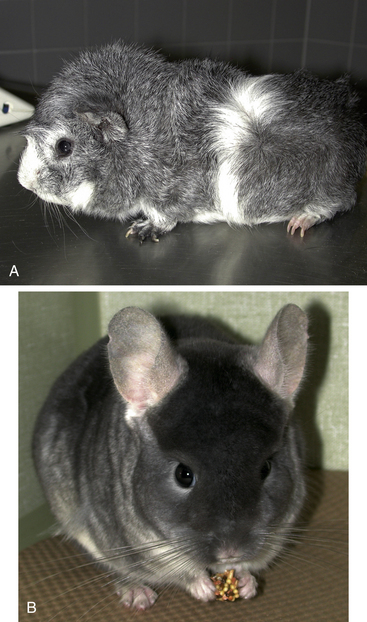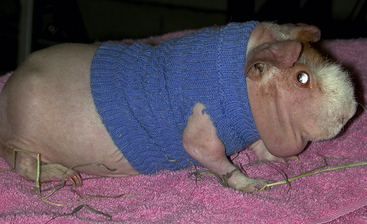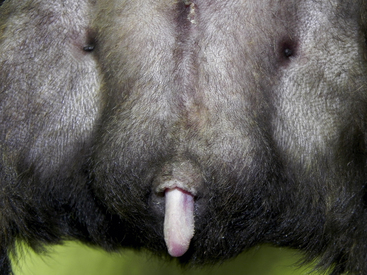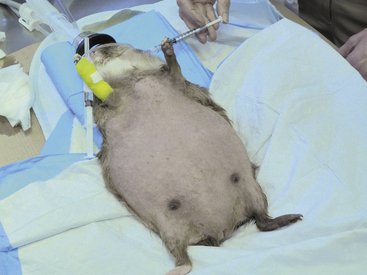Chapter 22 Biology, Husbandry, and Clinical Techniques of Guinea Pigs and Chinchillas
Guinea pigs (Cavia porcellus) and chinchillas (Chinchilla laniger) are hystricomorph rodents from South America (Fig. 22-1). They share many anatomic and physiologic characteristics and the approach to their veterinary care is similar. Both species are monogastric herbivores with a large cecum, and both produce precocious young after a relatively long gestation period. There are also some important differences between the two species. For example, guinea pigs require a dietary source of vitamin C but chinchillas do not; dystocia is common in guinea pigs but not in chinchillas; and chinchillas require dust baths but guinea pigs do not. Both guinea pigs and chinchillas are small, gentle, lively species that make good pets because they are docile and relatively easy to care for.
This chapter summarizes the information on basic biology, husbandry, and clinical techniques that is relevant to the medical care of these species as pets. Readers who are interested in more detailed descriptions of anatomy and physiology of guinea pigs can find these in the references.6,46,52 Guinea pigs have been used as laboratory animals for more than 500 years, and abundant information is available about them; until recently, less has been published about chinchillas.
Biology and Husbandry of Guinea Pigs
Guinea pigs, also known as cavies, were domesticated in South America between a.d. 500 and 1000 and possibly as early as 1000 b.c.66 At the time of the Spanish invasion of South America, guinea pigs, known as cuy, were raised by the Incas for food and for use in religious ceremonies.66 Guinea pigs were brought to Europe about 500 years ago. Although they never became popular as a food source outside of South America, in Europe and North America they have been raised as pets and laboratory animals ever since. Domestic guinea pigs remain a very important food source with a very high protein content (19%) for many people in the Altiplano region of South America.19 They are raised by families and often left uncaged to forage for food about the dwellings.61,66 A larger breed, weighing up to 2.5 lb (1.1 kg), was recently developed by researchers at La Molina National University to promote exportation as a food product to Peruvian immigrant populations in the United States, Japan, and Europe.14 Guinea pigs have been introduced into the Democratic Republic of the Congo as “microlivestock” to serve as a food source in that impoverished country.53
Several species of wild cavy are described (Cavia aperea, Cavia intermeida, Cavia fulgida, Cavia magna, and Cavia tschudii)71 and are found today in Colombia, Venezuela, Brazil, Argentina, Paraguay, and Peru.61,66 They inhabit a wide variety of habitats, including grasslands, the forest edge, swamps, and rocky areas.
The American Rabbit Breeders Association originally recognized three standard breeds of domestic guinea pigs: the American (or English), the Abyssinian, and the Peruvian. The American guinea pig has short smooth hair, the Abyssinian has relatively short coarse hair that grows in whorls or rosettes, and the Peruvian has very long (up to 15 cm) silky hair. Currently, the American Cavy Breeders Association (www.acbaonline.com) recognizes at least 13 breeds, and the British Cavy Council (www.britishcavycouncil.org.uk) recognizes at least 22 breeds, with published breed standards. New breeds and varieties are constantly being added. Newer recognized breeds include the Texel, which has long hair in ringlets and curls all over its body; the Teddy, which has a short dense coat with a kinked hair shaft; and the Silkie (or Sheltie), which is similar to the Peruvian except that long hair does not cover its face. Additionally, several hairless breeds have been developed by cavy breeders, such as the Skinny, which is hairless except for the head and lower legs (Fig. 22-2), and the Baldwin, which is born with hair but becomes totally bald at weaning. Each breed has different varieties of color and markings, including white, red, tan, brown, chocolate, and black; coats can be monochromatic, bicolored, or tricolored. A solid color is described as self; for example, black self is monochromatic black. The Himalayan color variety has a white body with black or chocolate nose, ears, and feet. Roan describes a coat of mixed black and white hairs. Agouti guinea pigs have an undercolor that is ticked throughout with another color, similar to wild guinea pigs. Dalmatian guinea pigs have a white body with black spotting. Albino guinea pigs are common in a laboratory setting.
Anatomy and Physiology
General Characteristics
Guinea pigs have stocky bodies, delicate short limbs, rounded hairless pinnae, and no tails. Males are larger than females, weighing 900 to 1,200 g compared with 700 to 900 g for females. Obesity is relatively common in pet animals. The lifespan of pet guinea pigs is typically 5 to 6 years. Wild cavies feed at dawn and dusk; they live in small groups (5 to 10 individuals) in burrows or crevices.61
The hair coat of guinea pigs is composed of large guard hairs surrounded by an undercoat of fine hairs. Androgen-dependent sebaceous glands are abundant along the dorsum and around the anus. The sebaceous glands around the anal area are important for marking, and the guinea pig is frequently seen rubbing or pressing its rump against a surface.6 In older males, excessive accumulation of sebaceous secretions occurs in the skin around the base of the spine, resulting in thick, matted, greasy fur. Breeders may call this a “grease gland.” Both male and female guinea pigs have one pair of inguinal nipples (Figs. 22-3 and 22-4).
Guinea pigs have large tympanic bullae. They have 32 to 36 vertebrae; the vertebral formula is C7, T13(14), L6, S2(3), Cd4(6). There are 13 to 14 pairs of ribs, of which the last one or two are cartilaginous. The small cylindrical clavicle attaches laterally to the coracoid process of the scapula and medially to the manubrium. The pelvic symphysis generally remains fibrocartilaginous,6 and a gap in the symphysis can be palpated at the time of impending parturition. Guinea pigs have four digits on the front feet and three on the rear feet; each has a short claw that may require periodic clipping in some individuals.
The spleen is relatively broad in guinea pigs. The thymus in immature animals is located within the ventral cervical area and the cranial mediastinum; in adults, a thymic remnant may be present in the cranial mediastinum.6 Guinea pigs, like monkeys, ferrets, and humans, are considered to be corticosteroid-resistant species because steroid administration is not associated with marked changes in thymic physiology or peripheral lymphocyte counts.
Guinea pigs have no laryngeal ventricles, and their vocal folds are small; nonetheless, they command a wide range of vocalizations. The right lung is composed of four lobes (cranial, middle, caudal, and accessory), whereas the left lung is composed of three lobes (cranial, middle, and caudal). In the heart, as in other mammals, the right atrioventricular valve is tricuspid and the left is bicuspid. There is usually one septomarginal trabecula (moderator band) within the lumen of the right ventricle; there is rarely such a band within that of the left ventricle.6
Gastrointestinal System
The dental formula of guinea pigs is 2(I11, C00, PM11, M33) = 20. All teeth are elodont and grow throughout life. In animals with dental malocclusion, the maxillary cheek teeth tend to overgrow laterally into the buccal gingival; the mandibular cheek teeth tend to overgrow in a medial direction, entrapping the tongue (see Chapter 32). The incisors are normally white, unlike those of many other rodents. Between the incisors and the cheek teeth (premolars and molars) is a gap called the diastema.
Guinea pigs have large tongues and relatively small, narrow oral cavities. The soft palate is continuous with the base of the tongue. The oropharynx communicates with the remainder of the pharynx through a hole in the soft palate called the palatal ostium.58 Take care in attempting to pass any instrument (such as a feeding tube) that the instrument does not slip to either side of the ostium, where it can damage the vascular soft palate.
Guinea pigs have four pairs of salivary glands—parotid, mandibular, sublingual, and molar—the ducts of which empty into the oral cavity near the molars. The entire alimentary tract measures approximately 2.3 m from pharynx to anus.30 The stomach is lined with glandular epithelium; unlike the stomachs of rats, mice, and hamsters, there is no nonglandular portion.6 The small intestine is located on the right side of the abdominal cavity, and the cecum occupies the central and left portions. The cecum is a large, thin-walled sac with many lateral pouches formed by the action of three taeniae coli (thick, longitudinal muscular bands that run the length of the large intestine). Smooth muscle cells harvested from the taeniae coli of guinea pigs were commonly used in physiologic studies because they could be obtained easily without damaging the gut. The cecum is 15 to 20 cm long and contains up to 65% of the gastrointestinal (GI) contents.34 The liver has six lobes—right, medial, left lateral, left medial, caudate, and quadrate. The gallbladder is well developed.
The normal gastric emptying time in guinea pigs is 2 hours. Total GI transit time is approximately 20 hours (range 8-30 hours); however, when coprophagy is factored in, the total GI transit time is 66 hours.30
The mean gastric pH in laboratory guinea pigs is 2.9, whereas the small intestinal pH is in the range of 6.4 to 7.4.35 Water content in the GI tract in relation to body weight is higher in the guinea pig than in the rabbit, but water content is less than in the rabbit when normalized to unit length of the gut.
As herbivorous hindgut fermenters, guinea pigs are coprophagic and may ingest feces from the anus many times per day.17 Obese or pregnant animals may eat fecal pellets from the floor, and young, unweaned guinea pigs can be seen eating the dam’s droppings. Coprophagy appears to be an important function, although its contribution to the nutritional needs of guinea pigs has not been fully characterized. As in rabbits, coprophagy may be a source of B vitamins and a means of optimizing protein utilization.8 However, unlike rabbits, guinea are not cecotrophic; whereas cecotrophs provide a rich source of B vitamins for rabbits, guinea pigs require a dietary source of 7 out of 10 B vitamins, while rabbits require a dietary source for only 3.57 If coprophagy is prevented, guinea pigs lose weight, digest less fiber, and excrete more minerals in the feces.8,17 Small herbivores have one of two colonic separation mechanisms necessary for coprophagy.7,21 Guinea pigs and chinchillas exhibit a “mucus trap” strategy, in which bacteria from the cecum are trapped in mucus in the colon with few to no food particles and returned to the colon by antiperistalsis. Rabbits and other lagomorphs exhibit a “wash-back” strategy, in which bacteria, solutes, and small food particles are returned to the cecum by antiperistalsis in a stream of water from the proximal colon. The mucus-trap strategy is less efficient than the wash-back strategy in extracting bacteria from the colonic digesta.21 Therefore the colon of guinea pigs is comparatively larger and heavier than that of rabbits, which may be a factor in the ability of rabbits to run faster than other similarly sized mammals.21 Guinea pigs and chinchillas have a colonic furrow in the ascending colon, in which the concentration of bacteria and nitrogen is twice as high as in the lumen. Bacteria in the proximal colon are transported in the furrow into the cecum as part of the separation mechanism.26
Like the GI flora of rabbits, that of guinea pigs is primarily gram-positive.39 Anaerobic lactobacilli are the predominant bacterial species in the large intestine.8
Urogenital System
The accessory sex glands of male guinea pigs (boars) include the vesicular glands, prostate gland, coagulating glands, and bulbourethral glands. The vesicular glands are long, coiled, blind sacs that lie ventral to the ureters and extend 10 cm into the abdominal cavity.6 Do not mistake these for uterine horns! The testes are located in the open inguinal canals. Guinea pigs have an os penis. A pouch containing two horny styles (slender projections) is located caudoventral to the urethral opening. During erection, the pouch is everted and the styles project externally.
Female guinea pigs (sows) have paired uterine horns, a short uterine body (12 mm long), and a single os cervicis opening into the vagina. Guinea pigs have a vaginal closure membrane that opens at estrus, at parturition, and, in many animals, at day 26 or 27 of gestation.65
Sexing
Guinea pigs are easily sexed. Boars have obvious scrotal pouches and large testes (Fig. 22-3). A flat area of tissue lies between the urethral opening and the anus, in which a longitudinal shallow slit may be present, marking the junction of the two scrotal pouches on the midline. The penis can be everted from the prepuce by placing gentle pressure at its base.
Sows have a Y-shaped depression in the perineal tissues. The top branches of the Y point cranially and surround the urethral opening (Fig. 22-4). The vulvar opening lies at the intersection of the branches, and the anus is located at the base of the Y.
Reproductive Behavior and Breeding
Reproductive values for guinea pigs are presented in Table 22-1. Many reported features of the reproductive cycle (e.g., length of estrus and the estrous cycle, timing of postpartum estrus, litter size) vary according to the source, presumably because of variations among strains of guinea pigs. The numbers reported here are compiled from several different sources and are referenced accordingly.
Table 22-1 Physiologic Values for Guinea Pigs
| Usual life span as pet | 5-6 years |
| Adult weight | Males, 900-1200 g; females 700-900 g |
| Sexual maturity | Males, 3 months; females, 2 months |
| Type of estrous cycle | Nonseasonally polyestrous |
| Length of estrous cycle | 15-17 days |
| Ovulation | Spontaneous |
| Gestation period | 59-72 days (average, 68 days) |
| Litter size | 1-13 (2-4 is usual) |
| Normal birth weight | 45-115 g (70-110 g is usual) |
| Weaning age | 21 days (or at 180 g body weight) |
| Rectal temperature | 99.0-103.1°F (37.2-39.5°C) |
| Average blood volume | 70 mL/kg |
| Heart rate | 240-310 beats per minute |
Puberty, defined as age at first conception, occurs at 2 months of age in females and at 3 months in males.65 Males begin to mount at 1 month of age, and ejaculation is evident by the time they are 2 months old.23 The peak reproductive period for females is from 3 or 4 months to 20 months of age; pet animals may reproduce until they are 4 or 5 years old.34
Guinea pigs are polyestrous and breed year-round in a laboratory setting. The estrous cycle in most females is 15 to 17 days (range 13-21 days), and ovulation is spontaneous.34 Fertile postpartum estrus occurs in most females from 2 to 10 hours after parturition.52 Females show distinct signs of proestrus and estrus. During proestrus, they become more active and may chase their cage mates; they may sway their hindquarters and utter a distinct guttural sound. Estrus lasts 6 to 11 hours, during which time females show lordosis, or the copulatory reflex—an arching and straightening of the back with elevation of the rump and dilation of the vulva. In mature sows, the vaginal membrane is open for approximately 2 days during estrus; it closes after ovulation.
Copulation in guinea pigs (and chinchillas) can be confirmed by finding the vaginal (copulatory) plug, a solid mass of coagulated ejaculate that falls out of the vagina several hours after mating. Rodent copulatory plugs are typically hard and rubbery or waxy in consistency and are the exclusive product of male secretions. Copulatory plugs are not restricted to rodents and have been reported in some bats, insectivores, primates, and marsupials.16
There are several possible functions of rodent copulatory plugs.60 They may (1) store sperm, (2) prevent sperm leakage, (3) induce pseudopregnancy, (4) effect sperm transport, or (5) prevent later fertilization of the female by other males. Current hypotheses suggest that the primary function of the copulatory plug is the enforcement of chastity in polygamous breeding rodents. The other functions, especially sperm transport, are regarded as incidental but necessary effects. In guinea pigs, the copulatory plug prevents competing ejaculate from reaching the site of fertilization. This is also the case with chinchillas.
Impending parturition is signaled by separation of the pubic symphysis; a gap of 15 mm is palpable about 2 days before parturition and increases in width (up to 25 mm or more) at the time of parturition.23 This separation may be inadequate in sows that are bred for the first time after 7 or 8 months of age, and dystocia commonly results. Other causes of dystocia include obesity and large fetal size. Suspect dystocia in gravid sows that show depression or a bloody or discolored vaginal discharge; an emergency cesarean section is indicated in most cases (see Fig. 22-4).
Normal parturition is typically rapid, with only a few minutes between births. Guinea pigs do not build nests. The average litter size varies according to guinea pig strain and management practices but is typically 2 to 4,52,65 with a range of 1 to 13 young reported.65 Birth weights range from 45 to 115 g and are inversely related to litter size21; young weighing less than 60 g rarely survive.23 Although otherwise completely herbivorous, guinea pigs are placentophagic. In addition to the mother, males and other females may also consume the placenta.
Newborn guinea pigs (typically called pups or young but not piglets) are precocious, meaning that they are fully furred, their eyes are open, and they are able to stand shortly after birth. They are not, however, able to fend for themselves at this time.65 The pups ideally should receive sow’s milk for a minimum of 5 days, and the normal lactation period is 3 weeks.65 Pups often do not survive if they fail to receive sow’s milk for the first 3 to 4 days of life.23 Guinea pig sows are not very “motherly.” They passively allow nursing to occur rather than seeking out the young. Lactating sows permit the young of other females to nurse. Because voluntary micturition does not occur until the second week of life, the sow must lick the pup’s anogenital region to stimulate urination and defecation. The young are weaned at 21 days, or at a weight of 180 g (15-28 days of age).34
Orphaned guinea pigs should be fostered to a lactating sow if feasible. If there is no suitable foster mother, the young can be fed from a dropper or pet nurser beginning at 12 to 24 hours after birth. One author recommends feeding the pups every 2 hours until 5 days of age, after which feeding every 4 hours becomes sufficient. The hand-rearing formula should approximate guinea pig milk, which contains 4% fat, 8% protein, and 3% lactose.23 Evaporated milk mixed with an equal amount of water can be used. Guinea pigs begin nibbling on solid food at 2 days of age, and guinea pig pellets moistened with water or formula can be offered at that time.
Behavior
Guinea pigs are social animals that seek physical contact with other guinea pigs when housed together. They often stand side by side when resting and crowd together at feeders. However, there is little mutual grooming. Hair pulling can be a form of aggression, and hair pulling and ear nibbling of subordinate animals is seen in crowded or stressful environments.24
The vocalizations of guinea pigs have been well characterized. Recognized call types include the chutt, chutter, whine, tweet, whistle (single or in long bouts), purr, drr, scream, squeal, chirp, and grunt.5,24 Many guinea pig owners are familiar with the excited squeals emitted by their pets when a refrigerator door is opened or feeding is imminent.
Husbandry
Housing
In a laboratory setting in the United States, the minimum required floor space is 652 cm2 (101 in.2) per adult animal; however, guinea pigs in a laboratory are often group-housed and each animal has more than this amount of space. Pets should be provided with at least twice as much floor space. Cages may be constructed of plastic, metal, or wire. Good ventilation is important. If a solid-sided cage, such as an open glass aquarium, is used, change the bedding frequently to minimize ammonia levels in the cage. Guinea pigs do not jump or climb; therefore the top of the cage does not have to be enclosed. The cage walls should be at least 25 cm (10 in.) in height.
Place the cage in a quiet area out of direct sunlight. The recommended temperature range for guinea pigs is 65° to 79°F (18° to 26°C).23 Because of their susceptibility to hyperthermia, guinea pigs are better able to tolerate cool than warm environments and should not be exposed to high levels of temperatures and humidity.
For breeding purposes, guinea pigs are usually housed in a harem-style arrangement with a single boar and 1 to 10 sows in a pen.23 They can also be housed in pairs. In intensive breeding systems, the sow and young are left in the pen so that the sow can be rebred at the postpartum estrus. However, removal of the sow and young to a nursery area shortly after parturition minimizes trampling and ear chewing of the young by other adults.
Nutrition and Feeding
Wild cavies eat many different types of vegetation. Domestic guinea pigs are also completely herbivorous (with the exception of placentophagy). They digest fiber more efficiently than rabbits do.8 Interestingly, they do not increase their food intake, as do rabbits and many other species, when cellulose or other fiber is used to dilute the diet. This suggests that satiety in guinea pigs is governed more by distention of the GI tract than by metabolic energy need.8 A crude protein level of 18% to 20% is adequate for growth and lactation, and the recommended minimum level of crude fiber is 10%.7
Guinea pigs require a dietary source of vitamin C (ascorbic acid) because they lack l-gulonolactone oxidase, an enzyme involved in the synthesis of ascorbic acid from glucose. Nonbreeding adult guinea pigs require 10 mg/kg daily of ascorbic acid. Higher levels should be provided for growing and pregnant animals; 30 mg/kg daily is recommended during pregnancy.23
Commercially available guinea pig pellets usually contain 18% to 20% crude protein and 10% to 16% fiber.23 Pellets are fortified with ascorbic acid; however, approximately half of the initial vitamin C content may be oxidized and lost 90 days after the diet has been mixed and stored at 22°C. Many commercial diets are now available with stabilized vitamin C; these diets should be stored in a cool, dry area (<70°F [22°C]). Foods can be refrigerated or frozen but should be protected from condensation and increased storage temperature and humidity in vegetables and fruits or in the drinking water. Foods that contain high levels of ascorbic acid are red and green peppers, broccoli, tomatoes, kiwi fruit, and oranges. Many types of leafy greens (kale, parsley, beet greens, chicory, spinach) are high in vitamin C, but many contain high levels of calcium or oxalates; these should be offered in only small amounts. Vitamin C can be added to the water at 1 g/L.13 In an open container, water with added vitamin C loses more than 50% of its vitamin C content in 24 hours. Aqueous solutions of vitamin C deteriorate more rapidly in the presence of metal, hard water, or heat. Vitamin C is more stable in neutral to alkaline solutions. Water must be changed daily to ensure adequate activity of the vitamin.
Stay updated, free articles. Join our Telegram channel

Full access? Get Clinical Tree






